Attached files
| file | filename |
|---|---|
| 8-K - 8-K - REGIONS FINANCIAL CORP | rf1210138k.htm |
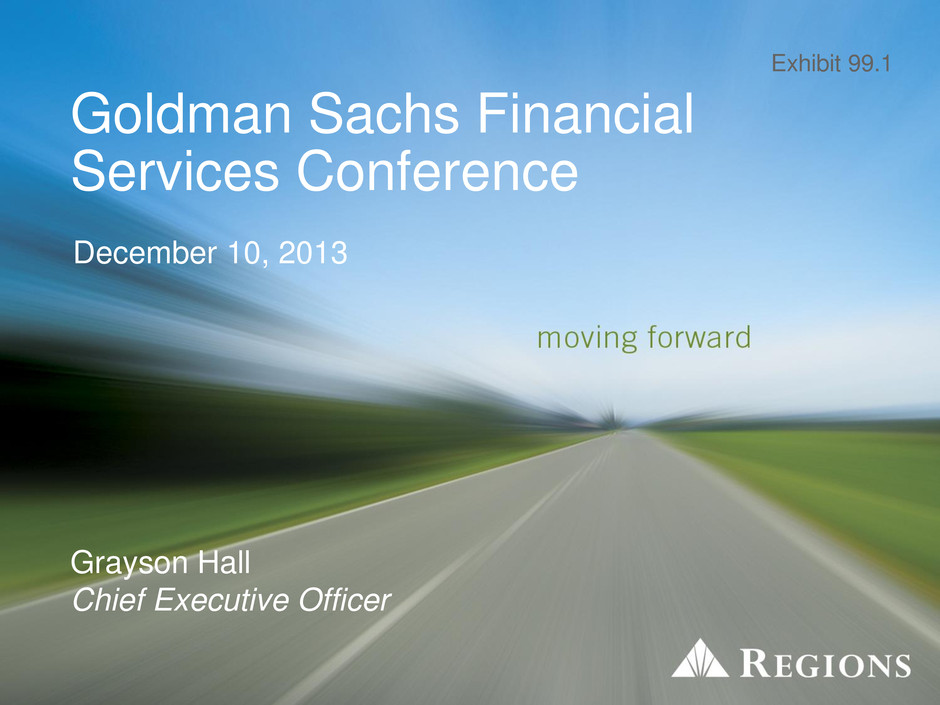
1 Goldman Sachs Financial Services Conference December 10, 2013 Grayson Hall Chief Executive Officer Exhibit 99.1
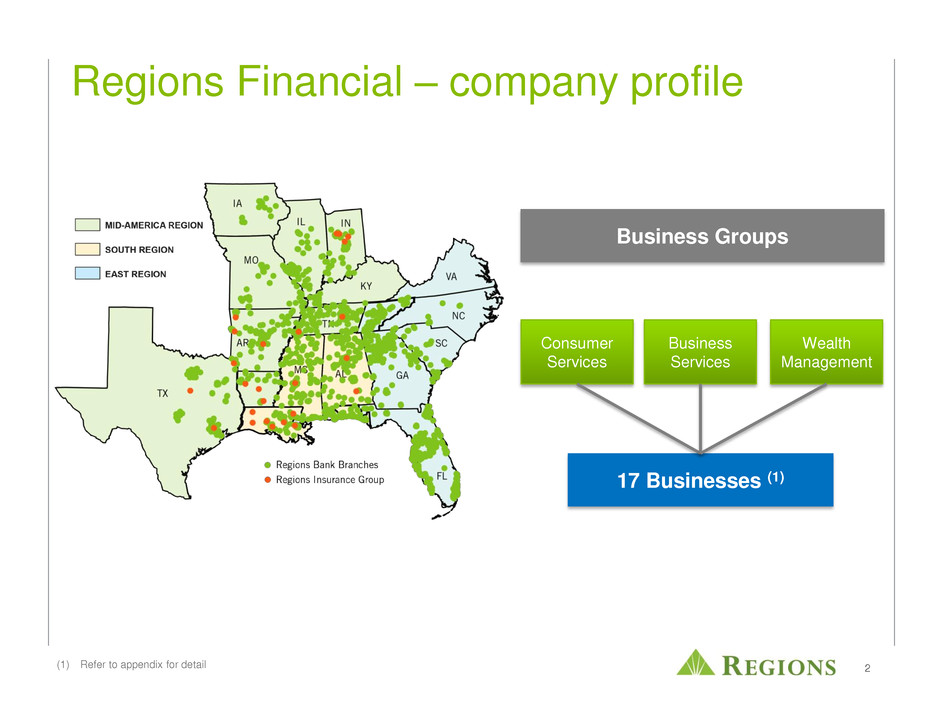
2 Regions Financial – company profile Consumer Services Business Services Wealth Management Business Groups 17 Businesses (1) (1) Refer to appendix for detail
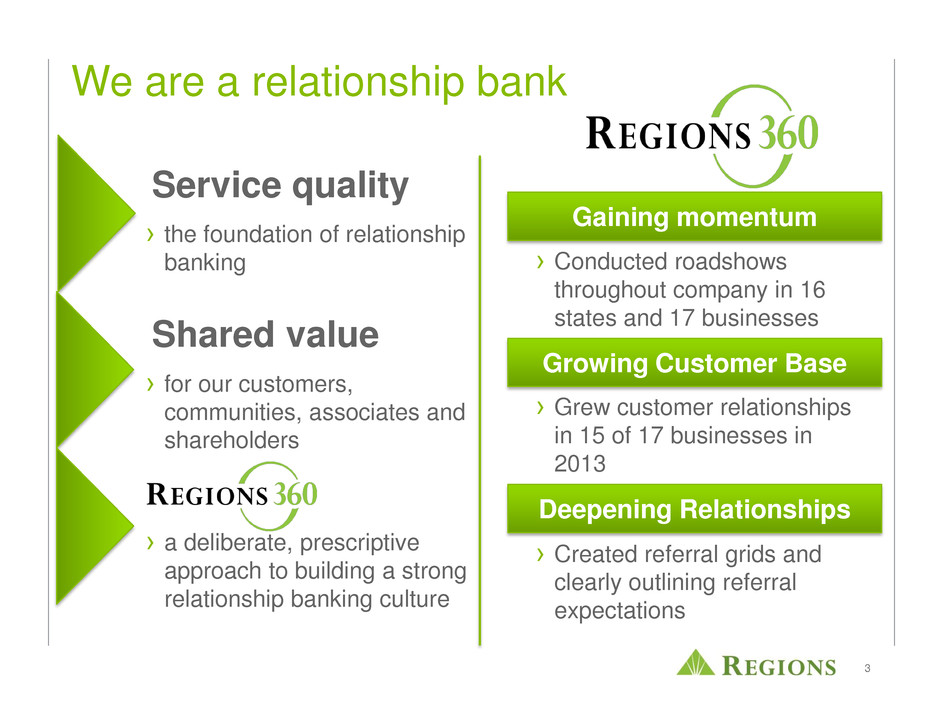
3 We are a relationship bank Service quality › the foundation of relationship banking Shared value › for our customers, communities, associates and shareholders › a deliberate, prescriptive approach to building a strong relationship banking culture Gaining momentum Growing Customer Base Deepening Relationships › Conducted roadshows throughout company in 16 states and 17 businesses › Grew customer relationships in 15 of 17 businesses in 2013 › Created referral grids and clearly outlining referral expectations
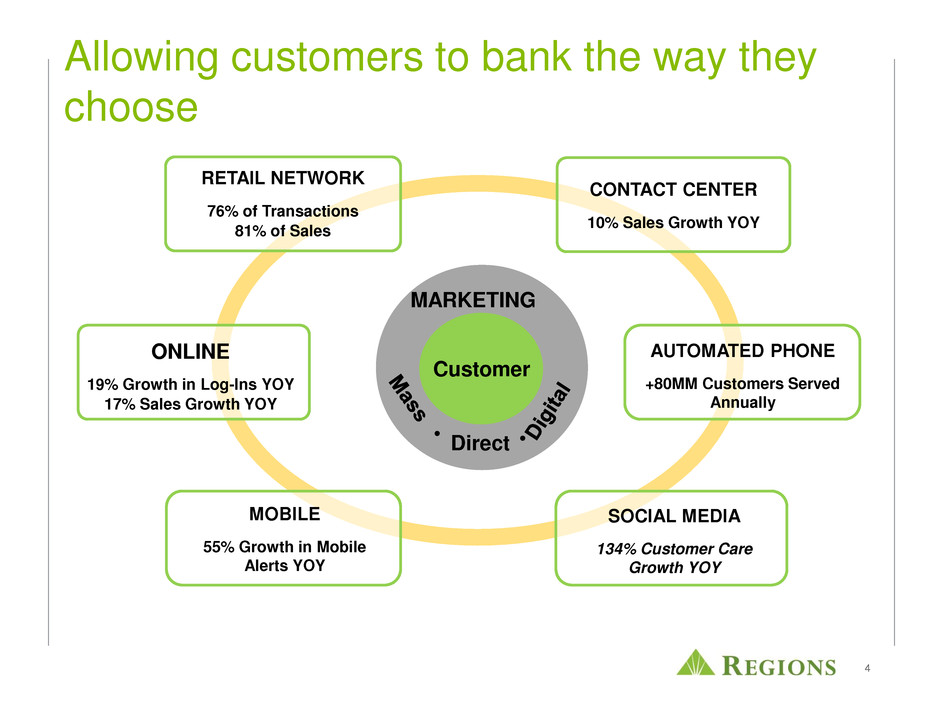
4 Allowing customers to bank the way they choose CONTACT CENTER 10% Sales Growth YOY AUTOMATED PHONE +80MM Customers Served Annually SOCIAL MEDIA 134% Customer Care Growth YOY Customer MARKETING Direct • • MOBILE 55% Growth in Mobile Alerts YOY RETAIL NETWORK 76% of Transactions 81% of Sales ONLINE 19% Growth in Log-Ins YOY 17% Sales Growth YOY
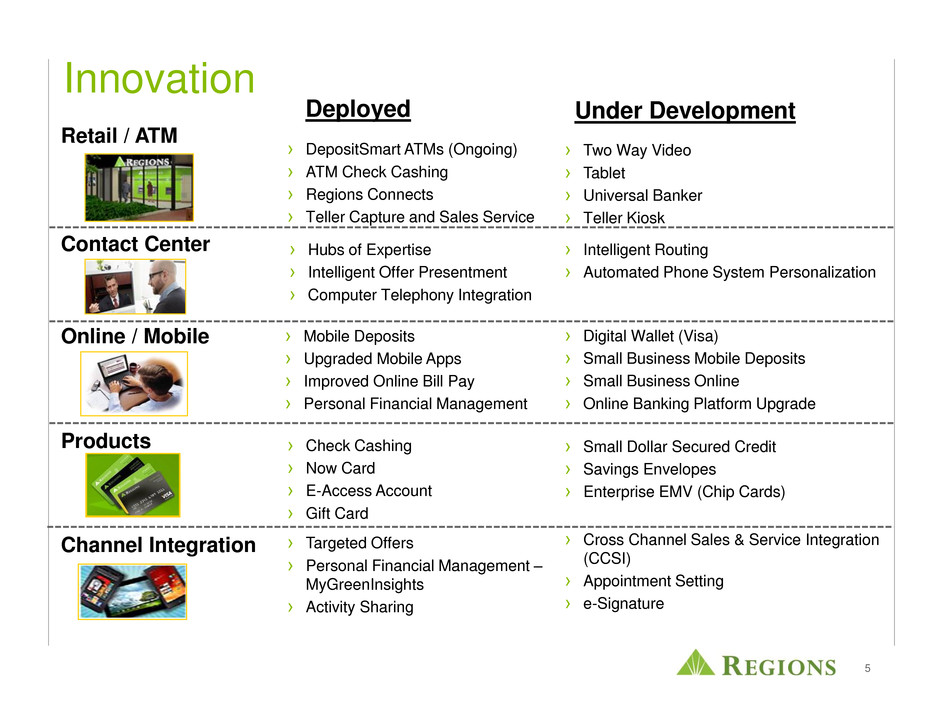
5 Innovation Retail / ATM › Two Way Video › Tablet › Universal Banker › Teller Kiosk Contact Center › Intelligent Routing › Automated Phone System Personalization Online / Mobile › Digital Wallet (Visa) › Small Business Mobile Deposits › Small Business Online › Online Banking Platform Upgrade Products › Small Dollar Secured Credit › Savings Envelopes › Enterprise EMV (Chip Cards) › DepositSmart ATMs (Ongoing) › ATM Check Cashing › Regions Connects › Teller Capture and Sales Service › Mobile Deposits › Upgraded Mobile Apps › Improved Online Bill Pay › Personal Financial Management Deployed Under Development › Check Cashing › Now Card › E-Access Account › Gift Card › Hubs of Expertise › Intelligent Offer Presentment › Computer Telephony Integration Channel Integration › Cross Channel Sales & Service Integration (CCSI) › Appointment Setting › e-Signature › Targeted Offers › Personal Financial Management – MyGreenInsights › Activity Sharing
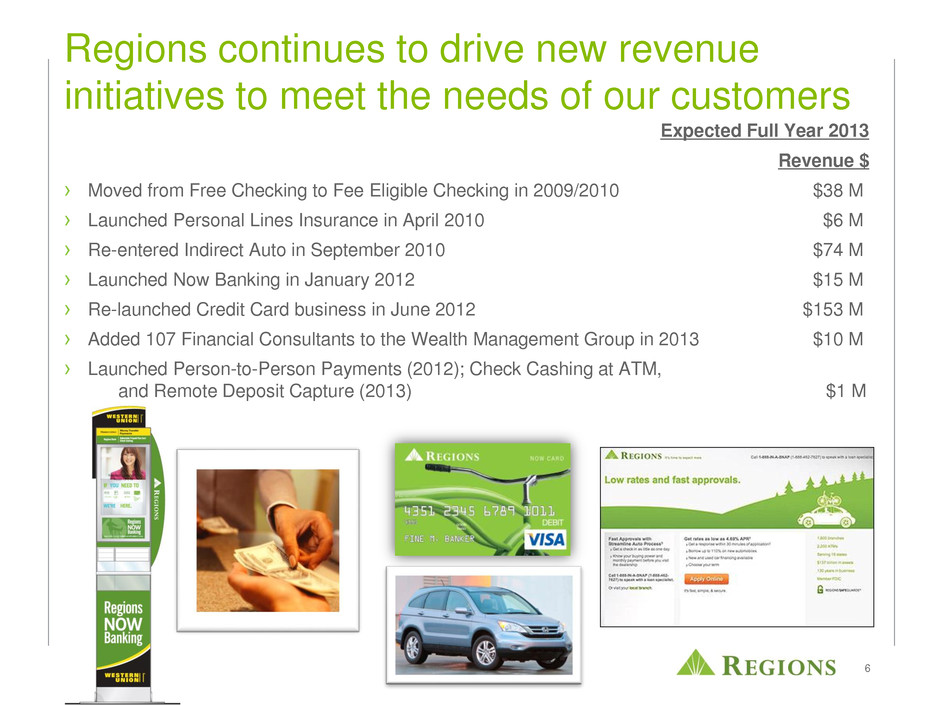
6 Expected Full Year 2013 Revenue $ › Moved from Free Checking to Fee Eligible Checking in 2009/2010 $38 M › Launched Personal Lines Insurance in April 2010 $6 M › Re-entered Indirect Auto in September 2010 $74 M › Launched Now Banking in January 2012 $15 M › Re-launched Credit Card business in June 2012 $153 M › Added 107 Financial Consultants to the Wealth Management Group in 2013 $10 M › Launched Person-to-Person Payments (2012); Check Cashing at ATM, and Remote Deposit Capture (2013) $1 M Regions continues to drive new revenue initiatives to meet the needs of our customers
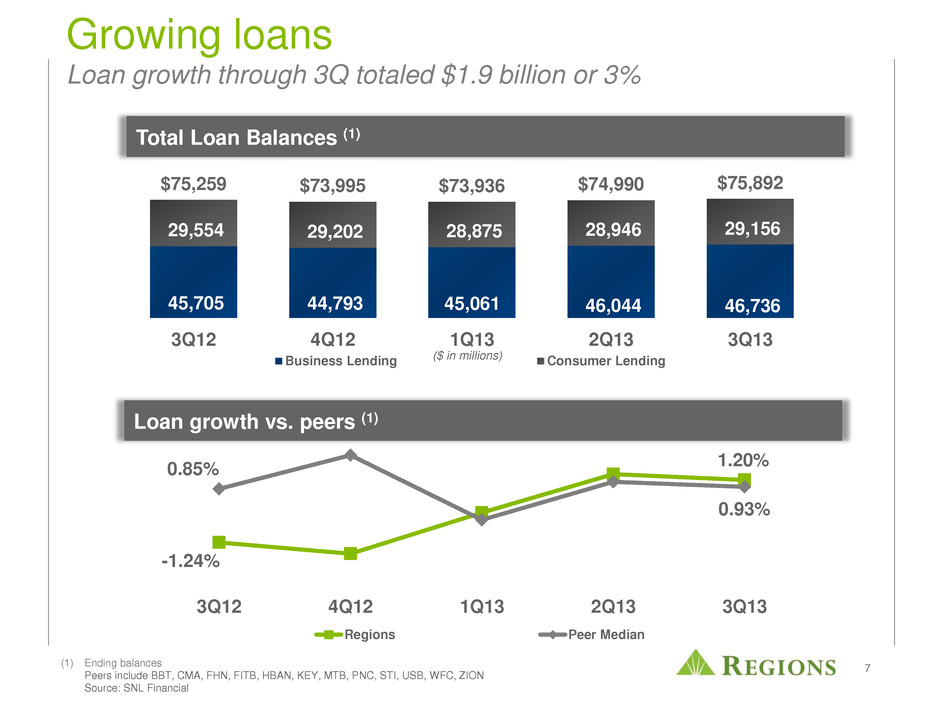
7 Growing loans Loan growth through 3Q totaled $1.9 billion or 3% Total Loan Balances (1) (1) Ending balances Peers include BBT, CMA, FHN, FITB, HBAN, KEY, MTB, PNC, STI, USB, WFC, ZION Source: SNL Financial ($ in millions) 45,705 44,793 45,061 46,044 46,736 29,554 29,202 28,875 28,946 29,156 $75,259 $73,995 $73,936 $74,990 $75,892 3Q12 4Q12 1Q13 2Q13 3Q13 Business Lending Consumer Lending -1.24% 1.20% 0.85% 0.93% 3Q12 4Q12 1Q13 2Q13 3Q13 Regions Peer Median Loan growth vs. peers (1)
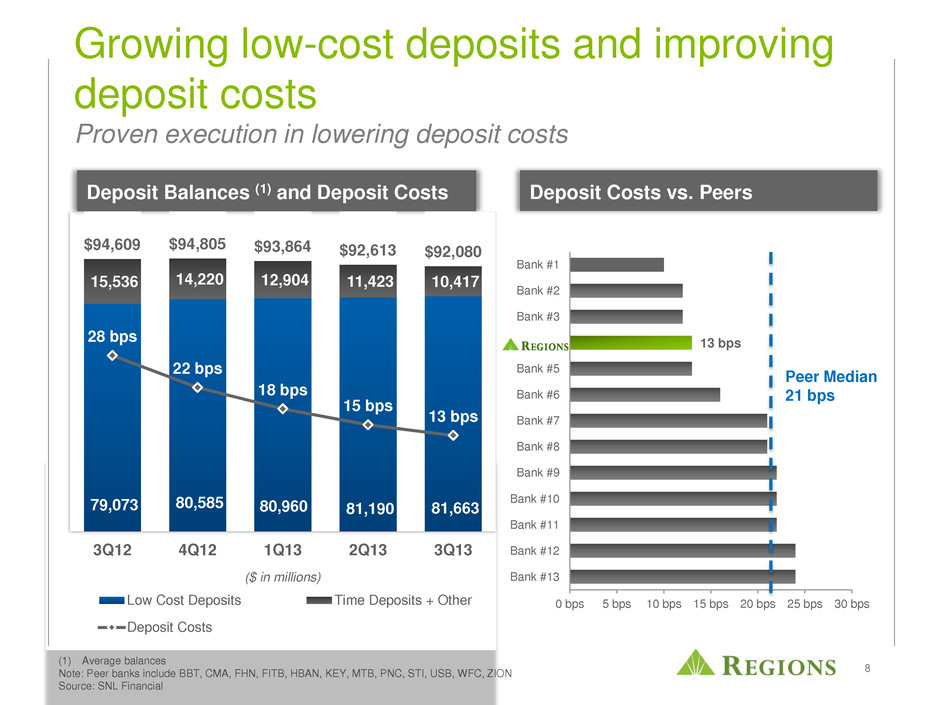
8 Growing low-cost deposits and improving deposit costs Proven execution in lowering deposit costs Deposit Balances (1) and Deposit Costs ($ in millions) (1) Average balances Note: Peer banks include BBT, CMA, FHN, FITB, HBAN, KEY, MTB, PNC, STI, USB, WFC, ZION Source: SNL Financial 13 bps 0 bps 5 bps 10 bps 15 bps 20 bps 25 bps 30 bps Bank #13 Bank #12 Bank #11 Bank #10 Bank #9 Bank #8 Bank #7 Bank #6 Bank #5 Bank #3 Bank #2 Bank #1 Deposit Costs vs. Peers 79,073 80,585 80,960 81,190 81,663 15,536 14,220 12,904 11,423 10,417 $94,609 $94,805 $93,864 $92,613 $92,080 28 bps 22 bps 18 bps 15 bps 13 bps 3Q12 4Q12 1Q13 2Q13 3Q13 Low Cost Deposits Time Deposits + Other Deposit Costs Peer Median 21 bps
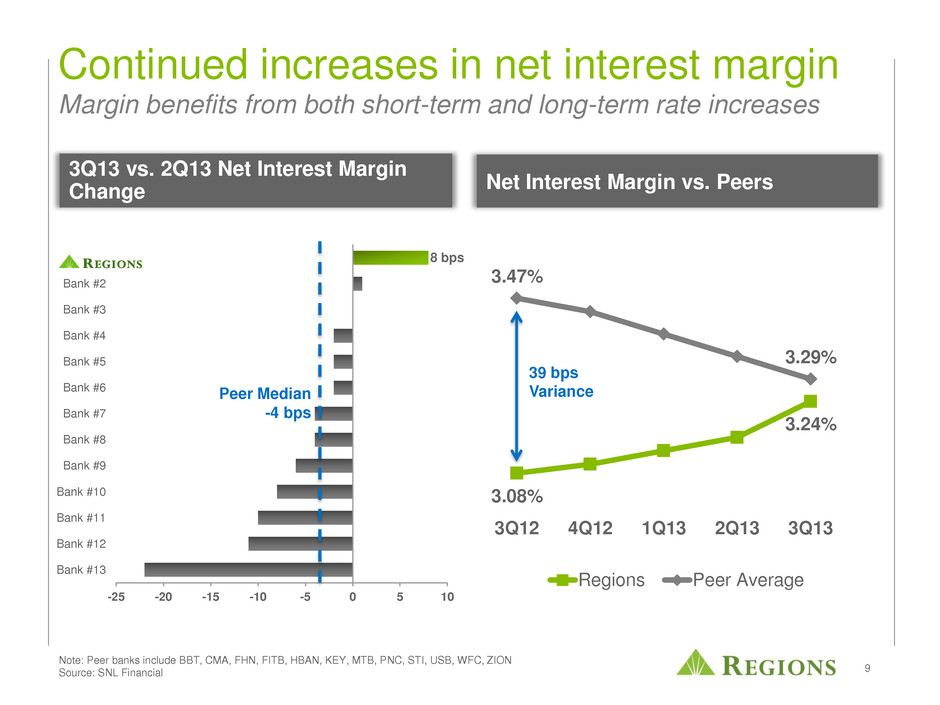
9 3.08% 3.24% 3.47% 3.29% 3Q12 4Q12 1Q13 2Q13 3Q13 Regions Peer Average Continued increases in net interest margin Margin benefits from both short-term and long-term rate increases Note: Peer banks include BBT, CMA, FHN, FITB, HBAN, KEY, MTB, PNC, STI, USB, WFC, ZION Source: SNL Financial Net Interest Margin vs. Peers 39 bps Variance 8 bps -25 -20 -15 -10 -5 0 5 10 Bank #13 Bank #12 Bank #11 Bank #10 Bank #9 Bank #8 Bank #7 Bank #6 Bank #5 Bank #4 Bank #3 Bank #2 Peer Median -4 bps 3Q13 vs. 2Q13 Net Interest Margin Change
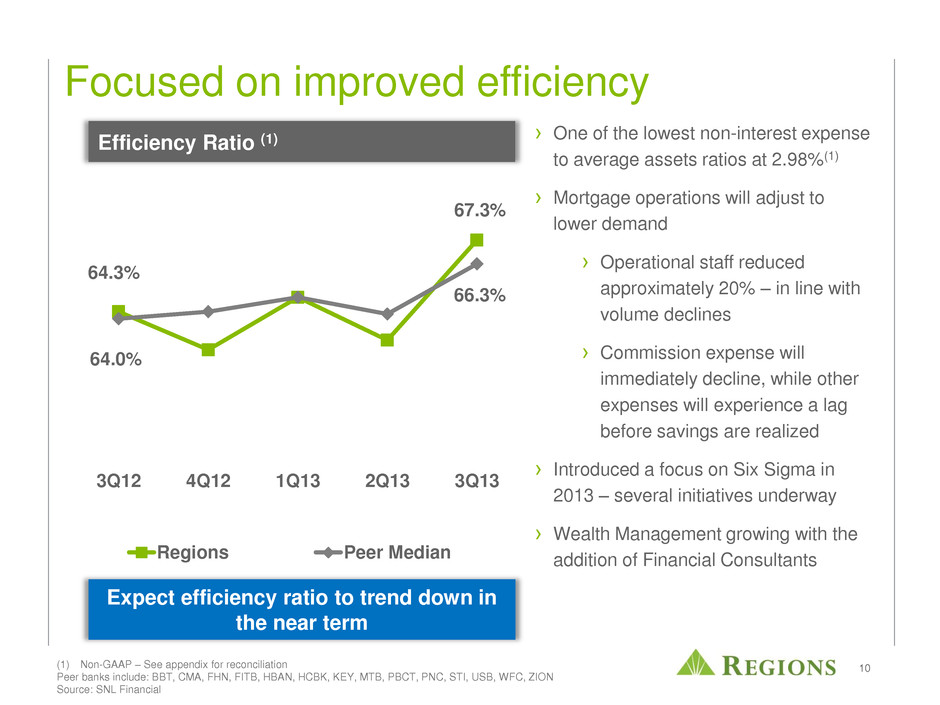
10 Focused on improved efficiency 64.3% 67.3% 64.0% 66.3% 3Q12 4Q12 1Q13 2Q13 3Q13 Regions Peer Median Efficiency Ratio (1) (1) Non-GAAP – See appendix for reconciliation Peer banks include: BBT, CMA, FHN, FITB, HBAN, HCBK, KEY, MTB, PBCT, PNC, STI, USB, WFC, ZION Source: SNL Financial › One of the lowest non-interest expense to average assets ratios at 2.98%(1) › Mortgage operations will adjust to lower demand › Operational staff reduced approximately 20% – in line with volume declines › Commission expense will immediately decline, while other expenses will experience a lag before savings are realized › Introduced a focus on Six Sigma in 2013 – several initiatives underway › Wealth Management growing with the addition of Financial Consultants Expect efficiency ratio to trend down in the near term
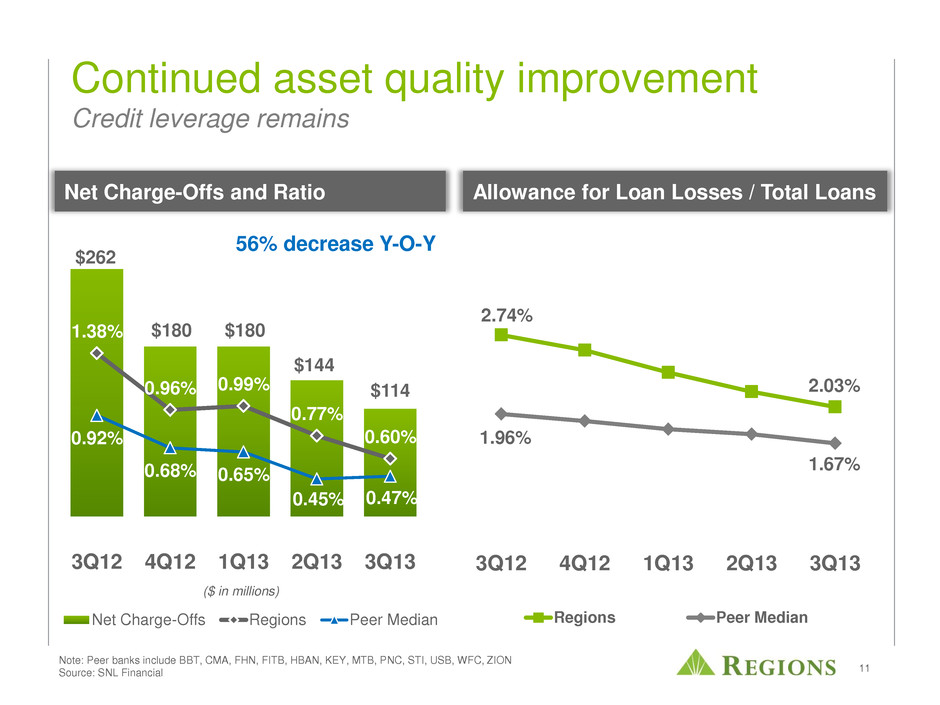
11 $262 $180 $180 $144 $114 1.38% 0.96% 0.99% 0.77% 0.60% 0.92% 0.68% 0.65% 0.45% 0.47% 3Q12 4Q12 1Q13 2Q13 3Q13 Net Charge-Offs Regions Peer Median Continued asset quality improvement Credit leverage remains 2.74% 2.03% 1.96% 1.67% 3Q12 4Q12 1Q13 2Q13 3Q13 Regions Peer Median Note: Peer banks include BBT, CMA, FHN, FITB, HBAN, KEY, MTB, PNC, STI, USB, WFC, ZION Source: SNL Financial 56% decrease Y-O-Y Allowance for Loan Losses / Total Loans Net Charge-Offs and Ratio ($ in millions)
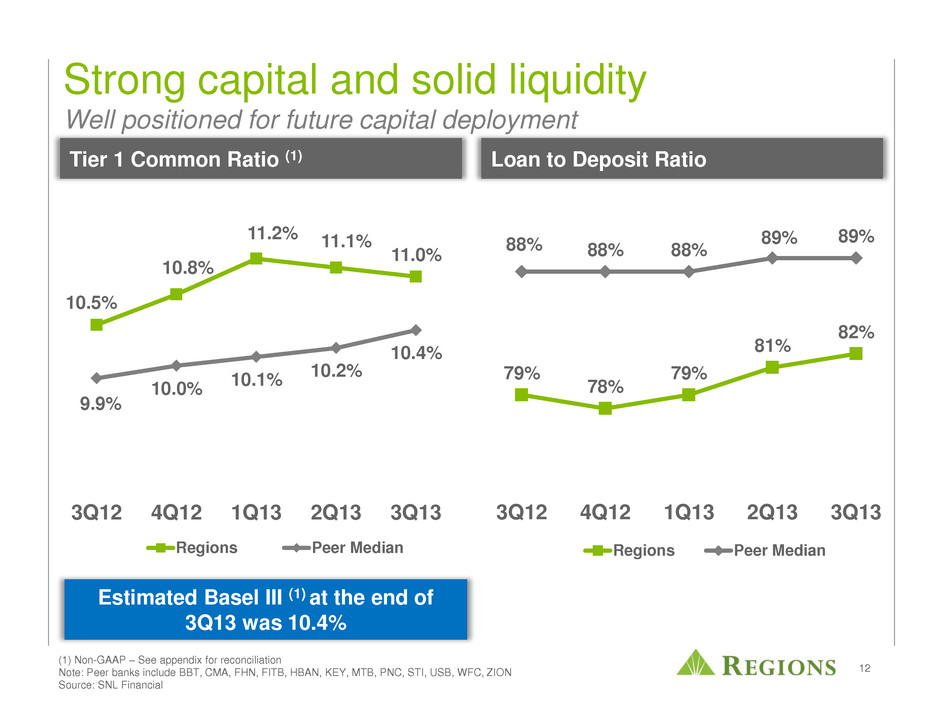
12 Strong capital and solid liquidity Well positioned for future capital deployment (1) Non-GAAP – See appendix for reconciliation Note: Peer banks include BBT, CMA, FHN, FITB, HBAN, KEY, MTB, PNC, STI, USB, WFC, ZION Source: SNL Financial 10.5% 10.8% 11.2% 11.1% 11.0% 9.9% 10.0% 10.1% 10.2% 10.4% 3Q12 4Q12 1Q13 2Q13 3Q13 Regions Peer Median 79% 78% 79% 81% 82% 88% 88% 88% 89% 89% 3Q12 4Q12 1Q13 2Q13 3Q13 Regions Peer Median Estimated Basel III (1) at the end of 3Q13 was 10.4% Loan to Deposit Ratio Tier 1 Common Ratio (1)
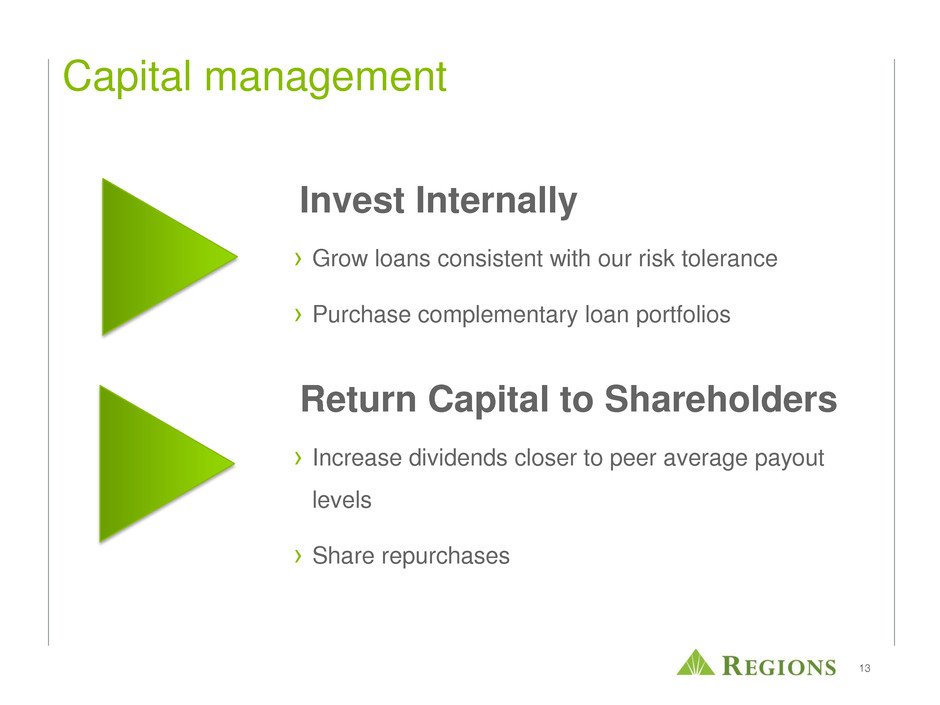
13 Capital management Invest Internally › Grow loans consistent with our risk tolerance › Purchase complementary loan portfolios Return Capital to Shareholders › Increase dividends closer to peer average payout levels › Share repurchases
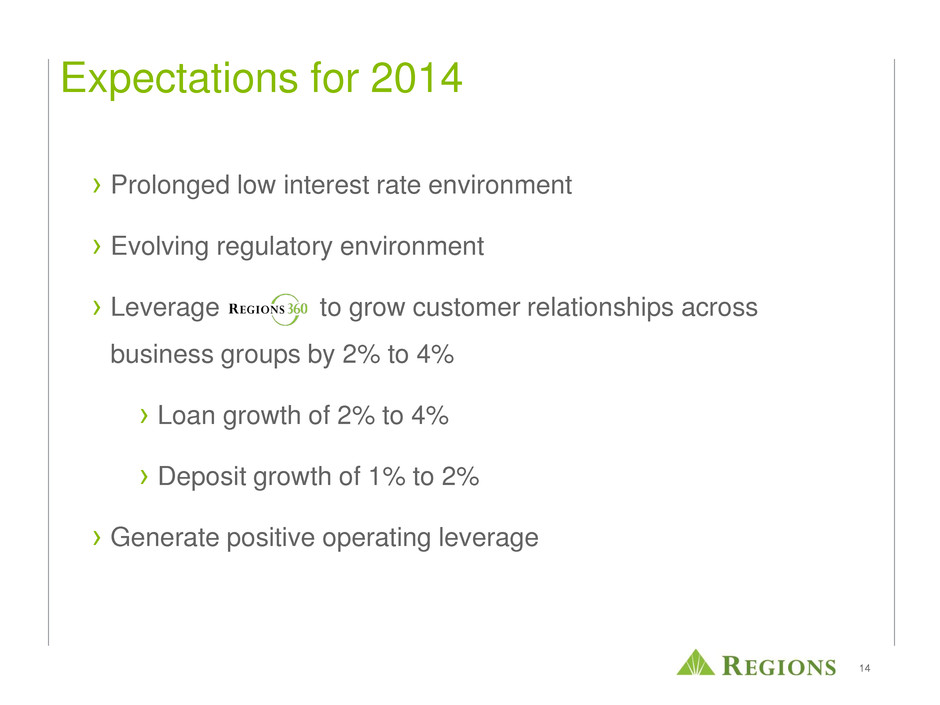
14 Expectations for 2014 › Prolonged low interest rate environment › Evolving regulatory environment › Leverage to grow customer relationships across business groups by 2% to 4% › Loan growth of 2% to 4% › Deposit growth of 1% to 2% › Generate positive operating leverage
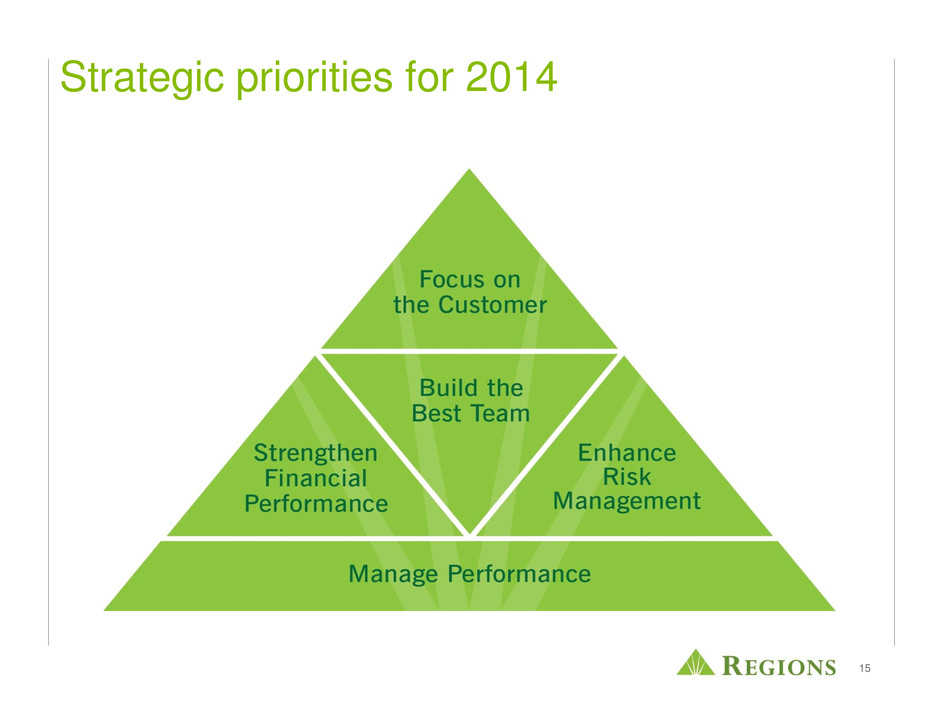
15 Strategic priorities for 2014
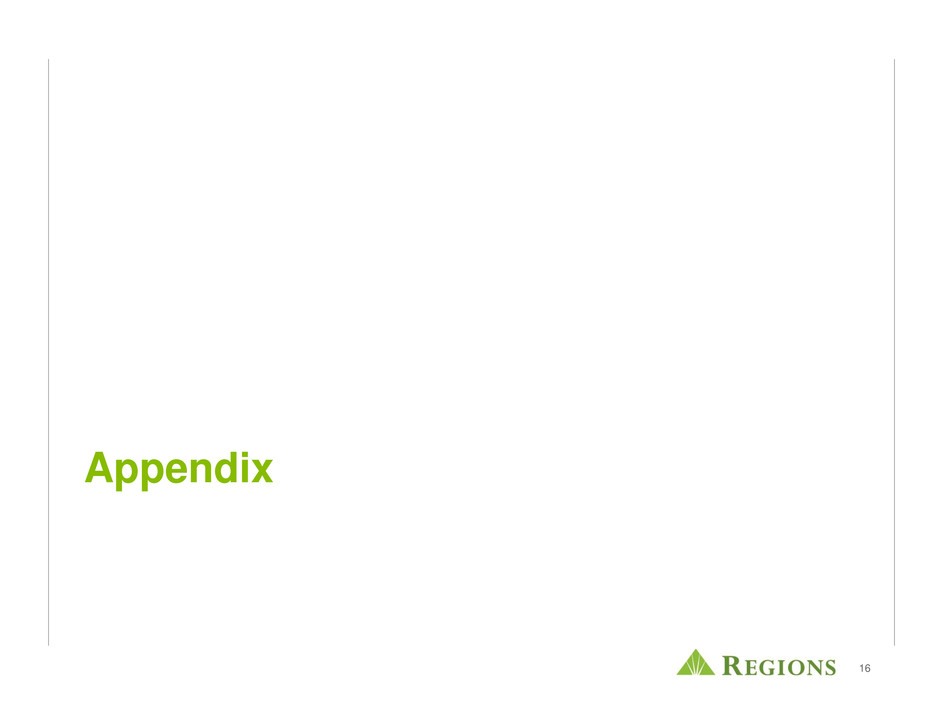
16 Appendix
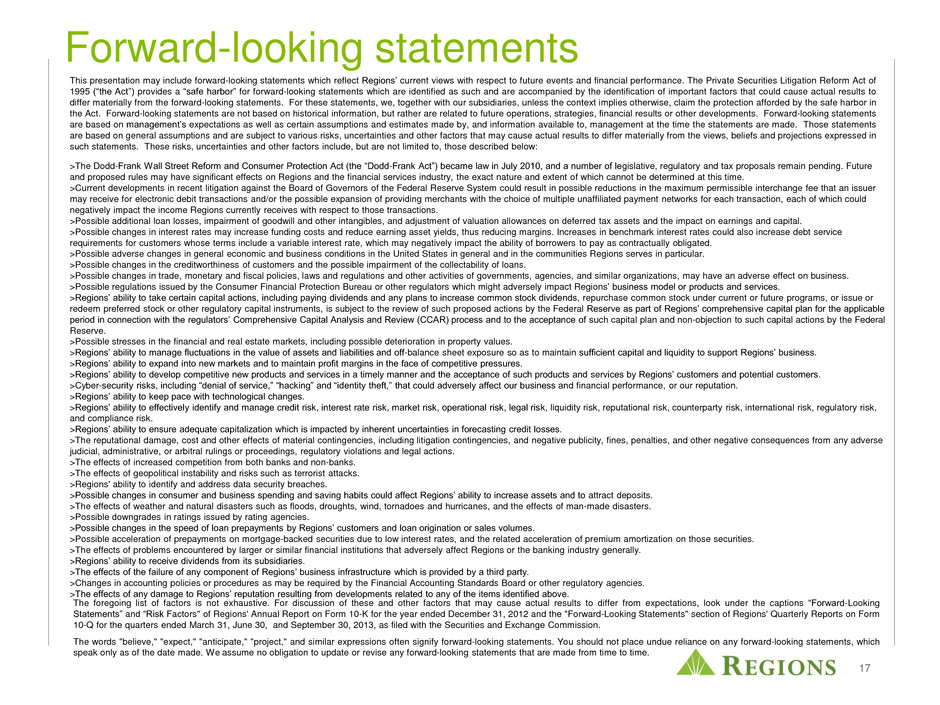
17 Forward-looking statements This presentation may include forward-looking statements which reflect Regions’ current views with respect to future events and financial performance. The Private Securities Litigation Reform Act of 1995 (“the Act”) provides a “safe harbor” for forward-looking statements which are identified as such and are accompanied by the identification of important factors that could cause actual results to differ materially from the forward-looking statements. For these statements, we, together with our subsidiaries, unless the context implies otherwise, claim the protection afforded by the safe harbor in the Act. Forward-looking statements are not based on historical information, but rather are related to future operations, strategies, financial results or other developments. Forward-looking statements are based on management’s expectations as well as certain assumptions and estimates made by, and information available to, management at the time the statements are made. Those statements are based on general assumptions and are subject to various risks, uncertainties and other factors that may cause actual results to differ materially from the views, beliefs and projections expressed in such statements. These risks, uncertainties and other factors include, but are not limited to, those described below: >The Dodd-Frank Wall Street Reform and Consumer Protection Act (the “Dodd-Frank Act”) became law in July 2010, and a number of legislative, regulatory and tax proposals remain pending. Future and proposed rules may have significant effects on Regions and the financial services industry, the exact nature and extent of which cannot be determined at this time. >Current developments in recent litigation against the Board of Governors of the Federal Reserve System could result in possible reductions in the maximum permissible interchange fee that an issuer may receive for electronic debit transactions and/or the possible expansion of providing merchants with the choice of multiple unaffiliated payment networks for each transaction, each of which could negatively impact the income Regions currently receives with respect to those transactions. >Possible additional loan losses, impairment of goodwill and other intangibles, and adjustment of valuation allowances on deferred tax assets and the impact on earnings and capital. >Possible changes in interest rates may increase funding costs and reduce earning asset yields, thus reducing margins. Increases in benchmark interest rates could also increase debt service requirements for customers whose terms include a variable interest rate, which may negatively impact the ability of borrowers to pay as contractually obligated. >Possible adverse changes in general economic and business conditions in the United States in general and in the communities Regions serves in particular. >Possible changes in the creditworthiness of customers and the possible impairment of the collectability of loans. >Possible changes in trade, monetary and fiscal policies, laws and regulations and other activities of governments, agencies, and similar organizations, may have an adverse effect on business. >Possible regulations issued by the Consumer Financial Protection Bureau or other regulators which might adversely impact Regions’ business model or products and services. >Regions’ ability to take certain capital actions, including paying dividends and any plans to increase common stock dividends, repurchase common stock under current or future programs, or issue or redeem preferred stock or other regulatory capital instruments, is subject to the review of such proposed actions by the Federal Reserve as part of Regions’ comprehensive capital plan for the applicable period in connection with the regulators’ Comprehensive Capital Analysis and Review (CCAR) process and to the acceptance of such capital plan and non-objection to such capital actions by the Federal Reserve. >Possible stresses in the financial and real estate markets, including possible deterioration in property values. >Regions’ ability to manage fluctuations in the value of assets and liabilities and off-balance sheet exposure so as to maintain sufficient capital and liquidity to support Regions’ business. >Regions’ ability to expand into new markets and to maintain profit margins in the face of competitive pressures. >Regions’ ability to develop competitive new products and services in a timely manner and the acceptance of such products and services by Regions’ customers and potential customers. >Cyber-security risks, including “denial of service,” “hacking” and “identity theft,” that could adversely affect our business and financial performance, or our reputation. >Regions’ ability to keep pace with technological changes. >Regions’ ability to effectively identify and manage credit risk, interest rate risk, market risk, operational risk, legal risk, liquidity risk, reputational risk, counterparty risk, international risk, regulatory risk, and compliance risk. >Regions’ ability to ensure adequate capitalization which is impacted by inherent uncertainties in forecasting credit losses. >The reputational damage, cost and other effects of material contingencies, including litigation contingencies, and negative publicity, fines, penalties, and other negative consequences from any adverse judicial, administrative, or arbitral rulings or proceedings, regulatory violations and legal actions. >The effects of increased competition from both banks and non-banks. >The effects of geopolitical instability and risks such as terrorist attacks. >Regions' ability to identify and address data security breaches. >Possible changes in consumer and business spending and saving habits could affect Regions’ ability to increase assets and to attract deposits. >The effects of weather and natural disasters such as floods, droughts, wind, tornadoes and hurricanes, and the effects of man-made disasters. >Possible downgrades in ratings issued by rating agencies. >Possible changes in the speed of loan prepayments by Regions’ customers and loan origination or sales volumes. >Possible acceleration of prepayments on mortgage-backed securities due to low interest rates, and the related acceleration of premium amortization on those securities. >The effects of problems encountered by larger or similar financial institutions that adversely affect Regions or the banking industry generally. >Regions’ ability to receive dividends from its subsidiaries. >The effects of the failure of any component of Regions’ business infrastructure which is provided by a third party. >Changes in accounting policies or procedures as may be required by the Financial Accounting Standards Board or other regulatory agencies. >The effects of any damage to Regions’ reputation resulting from developments related to any of the items identified above. The foregoing list of factors is not exhaustive. For discussion of these and other factors that may cause actual results to differ from expectations, look under the captions “Forward-Looking Statements” and “Risk Factors" of Regions' Annual Report on Form 10-K for the year ended December 31, 2012 and the "Forward-Looking Statements" section of Regions' Quarterly Reports on Form 10-Q for the quarters ended March 31, June 30, and September 30, 2013, as filed with the Securities and Exchange Commission. The words "believe," "expect," "anticipate," "project," and similar expressions often signify forward-looking statements. You should not place undue reliance on any forward-looking statements, which speak only as of the date made. We assume no obligation to update or revise any forward-looking statements that are made from time to time.
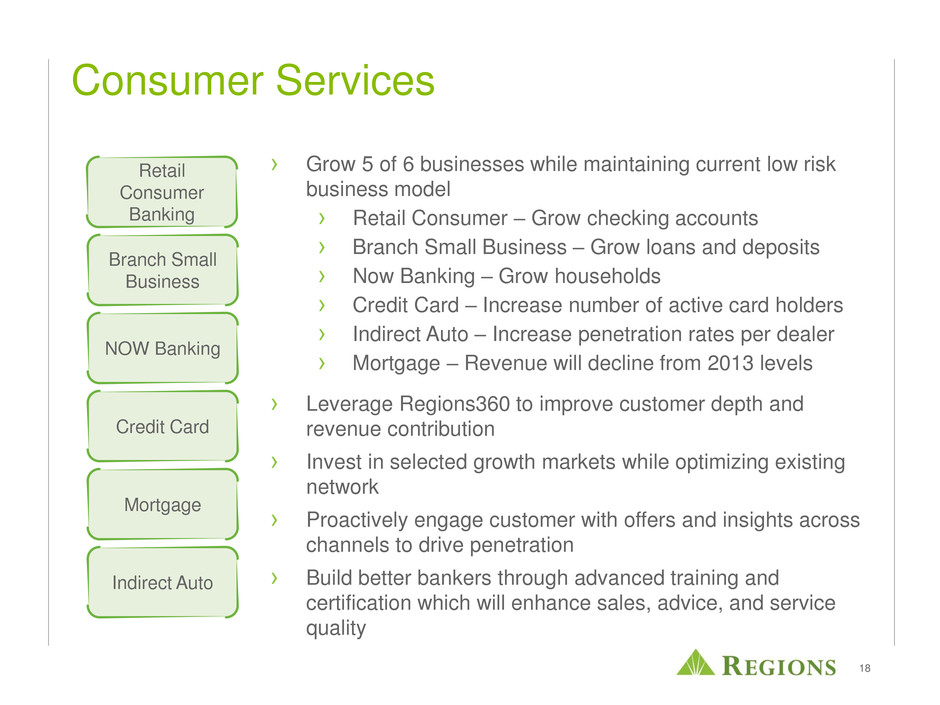
18 Consumer Services Retail Consumer Banking Branch Small Business NOW Banking Credit Card Mortgage Indirect Auto › Grow 5 of 6 businesses while maintaining current low risk business model › Retail Consumer – Grow checking accounts › Branch Small Business – Grow loans and deposits › Now Banking – Grow households › Credit Card – Increase number of active card holders › Indirect Auto – Increase penetration rates per dealer › Mortgage – Revenue will decline from 2013 levels › Leverage Regions360 to improve customer depth and revenue contribution › Invest in selected growth markets while optimizing existing network › Proactively engage customer with offers and insights across channels to drive penetration › Build better bankers through advanced training and certification which will enhance sales, advice, and service quality
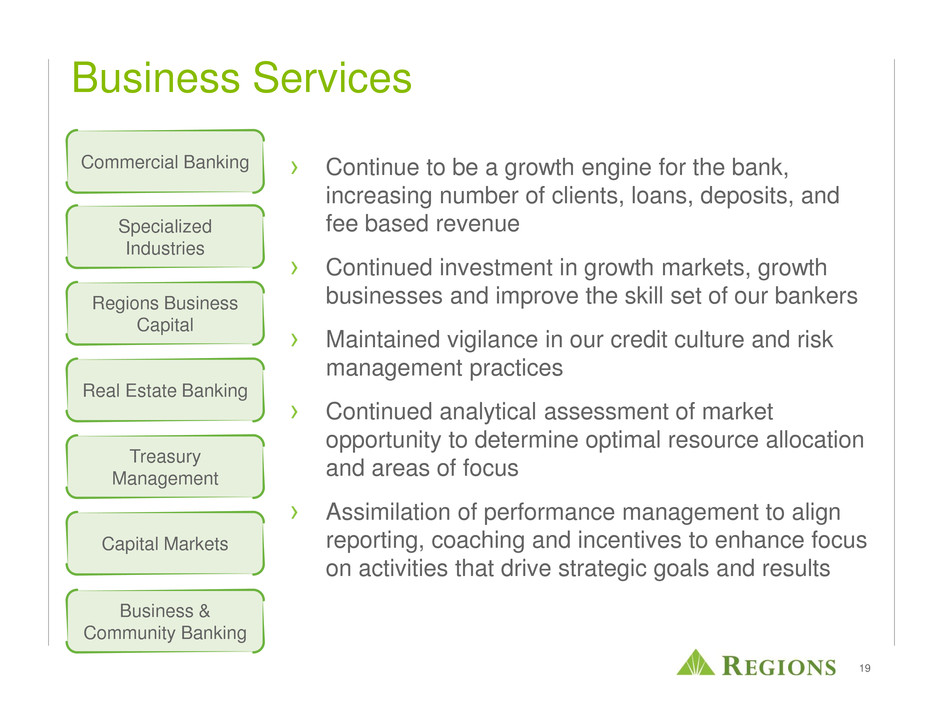
19 Business Services Commercial Banking Specialized Industries Regions Business Capital Real Estate Banking Treasury Management Capital Markets Business & Community Banking › Continue to be a growth engine for the bank, increasing number of clients, loans, deposits, and fee based revenue › Continued investment in growth markets, growth businesses and improve the skill set of our bankers › Maintained vigilance in our credit culture and risk management practices › Continued analytical assessment of market opportunity to determine optimal resource allocation and areas of focus › Assimilation of performance management to align reporting, coaching and incentives to enhance focus on activities that drive strategic goals and results
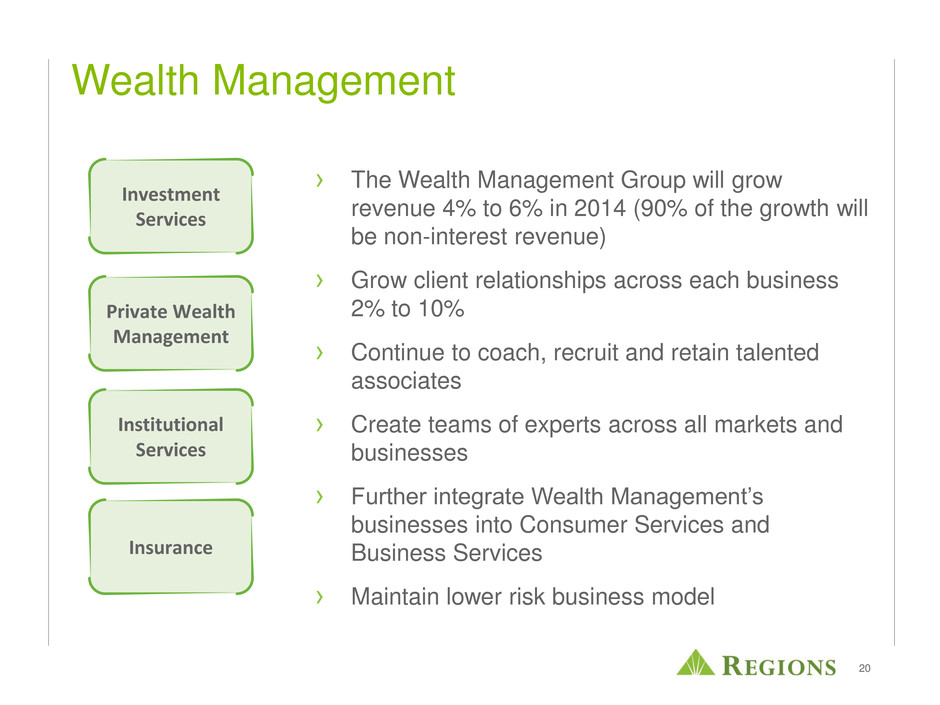
20 Wealth Management Investment Services Private Wealth Management Institutional Services Insurance › The Wealth Management Group will grow revenue 4% to 6% in 2014 (90% of the growth will be non-interest revenue) › Grow client relationships across each business 2% to 10% › Continue to coach, recruit and retain talented associates › Create teams of experts across all markets and businesses › Further integrate Wealth Management’s businesses into Consumer Services and Business Services › Maintain lower risk business model
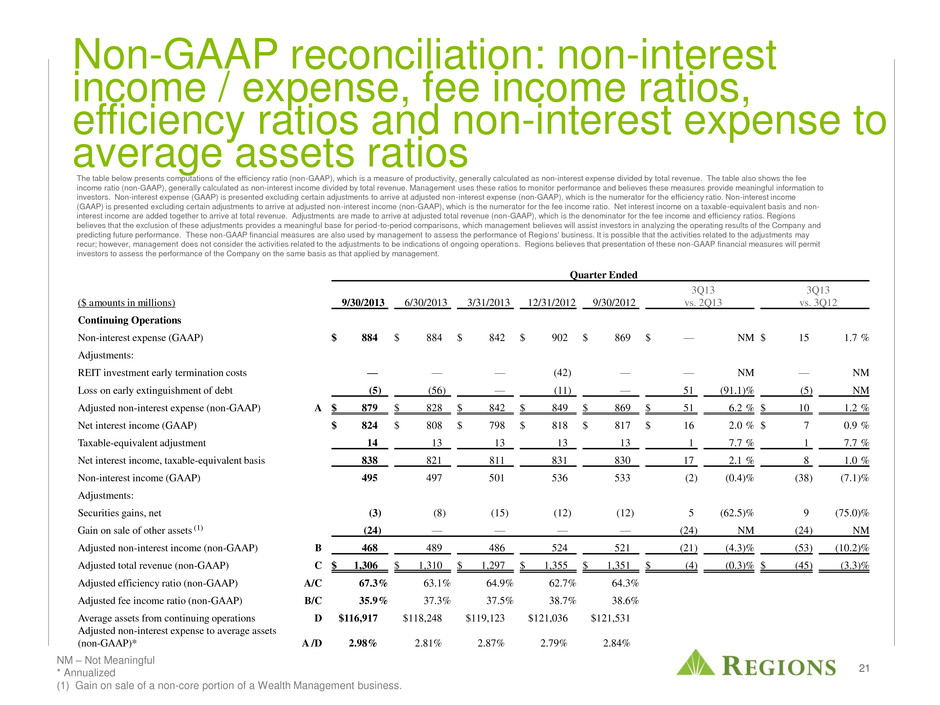
21 Non-GAAP reconciliation: non-interest income / expense, fee income ratios, efficiency ratios and non-interest expense to average assets ratios The table below presents computations of the efficiency ratio (non-GAAP), which is a measure of productivity, generally calculated as non-interest expense divided by total revenue. The table also shows the fee income ratio (non-GAAP), generally calculated as non-interest income divided by total revenue. Management uses these ratios to monitor performance and believes these measures provide meaningful information to investors. Non-interest expense (GAAP) is presented excluding certain adjustments to arrive at adjusted non-interest expense (non-GAAP), which is the numerator for the efficiency ratio. Non-interest income (GAAP) is presented excluding certain adjustments to arrive at adjusted non-interest income (non-GAAP), which is the numerator for the fee income ratio. Net interest income on a taxable-equivalent basis and non- interest income are added together to arrive at total revenue. Adjustments are made to arrive at adjusted total revenue (non-GAAP), which is the denominator for the fee income and efficiency ratios. Regions believes that the exclusion of these adjustments provides a meaningful base for period-to-period comparisons, which management believes will assist investors in analyzing the operating results of the Company and predicting future performance. These non-GAAP financial measures are also used by management to assess the performance of Regions' business. It is possible that the activities related to the adjustments may recur; however, management does not consider the activities related to the adjustments to be indications of ongoing operations. Regions believes that presentation of these non-GAAP financial measures will permit investors to assess the performance of the Company on the same basis as that applied by management. Quarter Ended ($ amounts in millions) 9/30/2013 6/30/2013 3/31/2013 12/31/2012 9/30/2012 3Q13 vs. 2Q13 3Q13 vs. 3Q12 Continuing Operations Non-interest expense (GAAP) $ 884 $ 884 $ 842 $ 902 $ 869 $ — NM $ 15 1.7 % Adjustments: REIT investment early termination costs — — — (42 ) — — NM — NM Loss on early extinguishment of debt (5 ) (56 ) — (11 ) — 51 (91.1 )% (5 ) NM Adjusted non-interest expense (non-GAAP) A $ 879 $ 828 $ 842 $ 849 $ 869 $ 51 6.2 % $ 10 1.2 % Net interest income (GAAP) $ 824 $ 808 $ 798 $ 818 $ 817 $ 16 2.0 % $ 7 0.9 % Taxable-equivalent adjustment 14 13 13 13 13 1 7.7 % 1 7.7 % Net interest income, taxable-equivalent basis 838 821 811 831 830 17 2.1 % 8 1.0 % Non-interest income (GAAP) 495 497 501 536 533 (2 ) (0.4 )% (38 ) (7.1 )% Adjustments: Securities gains, net (3 ) (8 ) (15 ) (12 ) (12 ) 5 (62.5 )% 9 (75.0 )% Gain on sale of other assets (1) (24 ) — — — — (24 ) NM (24 ) NM Adjusted non-interest income (non-GAAP) B 468 489 486 524 521 (21 ) (4.3 )% (53 ) (10.2 )% Adjusted total revenue (non-GAAP) C $ 1,306 $ 1,310 $ 1,297 $ 1,355 $ 1,351 $ (4 ) (0.3 )% $ (45 ) (3.3 )% Adjusted efficiency ratio (non-GAAP) A/C 67.3 % 63.1 % 64.9 % 62.7 % 64.3 % Adjusted fee income ratio (non-GAAP) B/C 35.9 % 37.3 % 37.5 % 38.7 % 38.6 % Average assets from continuing operations D $116,917 $118,248 $119,123 $121,036 $121,531 Adjusted non-interest expense to average assets (non-GAAP)* A /D 2.98% 2.81% 2.87% 2.79% 2.84% NM – Not Meaningful * Annualized (1) Gain on sale of a non-core portion of a Wealth Management business.
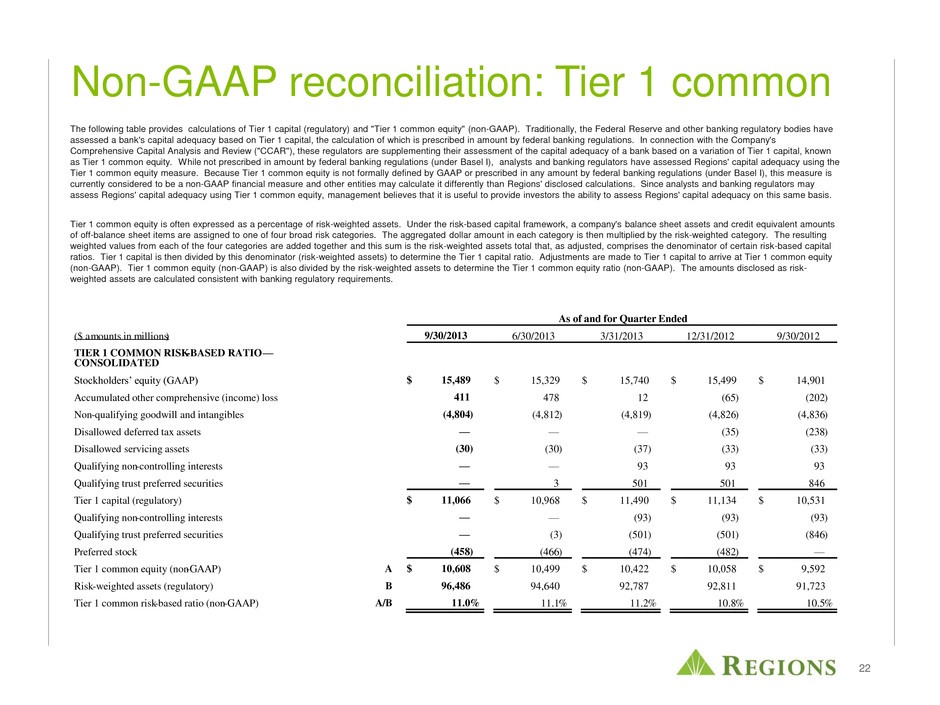
22 Non-GAAP reconciliation: Tier 1 common The following table provides calculations of Tier 1 capital (regulatory) and "Tier 1 common equity" (non-GAAP). Traditionally, the Federal Reserve and other banking regulatory bodies have assessed a bank's capital adequacy based on Tier 1 capital, the calculation of which is prescribed in amount by federal banking regulations. In connection with the Company's Comprehensive Capital Analysis and Review ("CCAR"), these regulators are supplementing their assessment of the capital adequacy of a bank based on a variation of Tier 1 capital, known as Tier 1 common equity. While not prescribed in amount by federal banking regulations (under Basel I), analysts and banking regulators have assessed Regions' capital adequacy using the Tier 1 common equity measure. Because Tier 1 common equity is not formally defined by GAAP or prescribed in any amount by federal banking regulations (under Basel I), this measure is currently considered to be a non-GAAP financial measure and other entities may calculate it differently than Regions' disclosed calculations. Since analysts and banking regulators may assess Regions' capital adequacy using Tier 1 common equity, management believes that it is useful to provide investors the ability to assess Regions' capital adequacy on this same basis. Tier 1 common equity is often expressed as a percentage of risk-weighted assets. Under the risk-based capital framework, a company's balance sheet assets and credit equivalent amounts of off-balance sheet items are assigned to one of four broad risk categories. The aggregated dollar amount in each category is then multiplied by the risk-weighted category. The resulting weighted values from each of the four categories are added together and this sum is the risk-weighted assets total that, as adjusted, comprises the denominator of certain risk-based capital ratios. Tier 1 capital is then divided by this denominator (risk-weighted assets) to determine the Tier 1 capital ratio. Adjustments are made to Tier 1 capital to arrive at Tier 1 common equity (non-GAAP). Tier 1 common equity (non-GAAP) is also divided by the risk-weighted assets to determine the Tier 1 common equity ratio (non-GAAP). The amounts disclosed as risk- weighted assets are calculated consistent with banking regulatory requirements. As of and for Quarter Ended ($ amounts in millions ) 9/30/2013 6/30/2013 3/31/2013 12/31/2012 9/30/2012 TIER 1 COMMON RISK -BASED RATIO — CONSOLIDATED Stockholders’ equity (GAAP) $ 15,489 $ 15,329 $ 15,740 $ 15,499 $ 14,901 Accumulated other comprehensive (income) loss 411 478 12 (65 ) (202 ) Non - qualifying goodwill and intangibles (4,804 ) (4,812 ) (4,819 ) (4,826 ) (4,836 ) Disallowed deferred tax assets — — — (35 ) (238 ) Disallowed servicing assets (30 ) (30 ) (37 ) (33 ) (33 ) Qualifying non - controlling interests — — 93 93 93 Qualifying trust preferred securities — 3 501 501 846 Tier 1 capital (regulatory) $ 11,066 $ 10,968 $ 11,490 $ 11,134 $ 10,531 Qualifying non - controlling interests — — (93 ) (93 ) (93 ) Qualifying trust preferred securities — (3 ) (501 ) (501 ) (846 ) Preferred stock (458 ) (466 ) (474 ) (482 ) — Tier 1 common equity (non -GAAP) A $ 10,608 $ 10,499 $ 10,422 $ 10,058 $ 9,592 Risk - weighted assets (regulatory) B 96,486 94,640 92,787 92,811 91,723 Tier 1 common risk - based ratio (non - GAAP) A / B 11.0 % 11.1 % 11.2 % 10.8 % 10.5 %
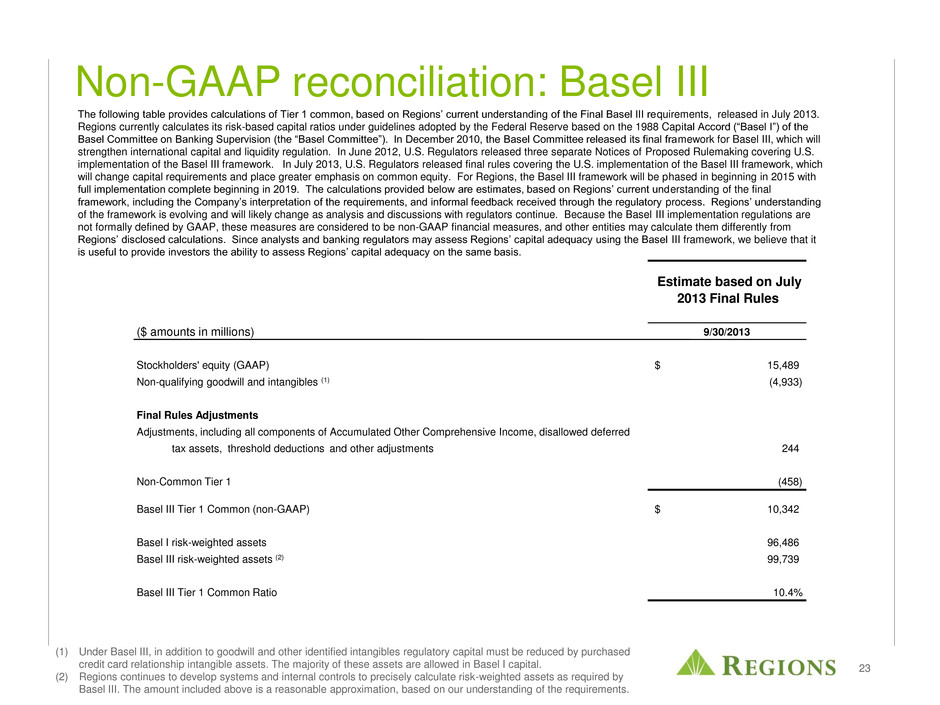
23 Non-GAAP reconciliation: Basel III (1) Under Basel III, in addition to goodwill and other identified intangibles regulatory capital must be reduced by purchased credit card relationship intangible assets. The majority of these assets are allowed in Basel I capital. (2) Regions continues to develop systems and internal controls to precisely calculate risk-weighted assets as required by Basel III. The amount included above is a reasonable approximation, based on our understanding of the requirements. The following table provides calculations of Tier 1 common, based on Regions’ current understanding of the Final Basel III requirements, released in July 2013. Regions currently calculates its risk-based capital ratios under guidelines adopted by the Federal Reserve based on the 1988 Capital Accord (“Basel I”) of the Basel Committee on Banking Supervision (the “Basel Committee”). In December 2010, the Basel Committee released its final framework for Basel III, which will strengthen international capital and liquidity regulation. In June 2012, U.S. Regulators released three separate Notices of Proposed Rulemaking covering U.S. implementation of the Basel III framework. In July 2013, U.S. Regulators released final rules covering the U.S. implementation of the Basel III framework, which will change capital requirements and place greater emphasis on common equity. For Regions, the Basel III framework will be phased in beginning in 2015 with full implementation complete beginning in 2019. The calculations provided below are estimates, based on Regions’ current understanding of the final framework, including the Company’s interpretation of the requirements, and informal feedback received through the regulatory process. Regions’ understanding of the framework is evolving and will likely change as analysis and discussions with regulators continue. Because the Basel III implementation regulations are not formally defined by GAAP, these measures are considered to be non-GAAP financial measures, and other entities may calculate them differently from Regions’ disclosed calculations. Since analysts and banking regulators may assess Regions’ capital adequacy using the Basel III framework, we believe that it is useful to provide investors the ability to assess Regions’ capital adequacy on the same basis. Estimate based on July 2013 Final Rules ($ amounts in millions) 9/30/2013 Stockholders' equity (GAAP) 15,489 $ Non-qualifying goodwill and intangibles (1) (4,933) Final Rules Adjustments Adjustments, including all components of Accumulated Other Comprehensive Income, disallowed deferred tax assets, threshold deductions and other adjustments 244 Non-Common Tier 1 (458) Basel III Tier 1 Common (non-GAAP) 10,342 $ Basel I risk-weighted assets 96,486 Basel III risk-weighted assets (2) 99,739 Basel III Tier 1 Common Ratio 10.4%
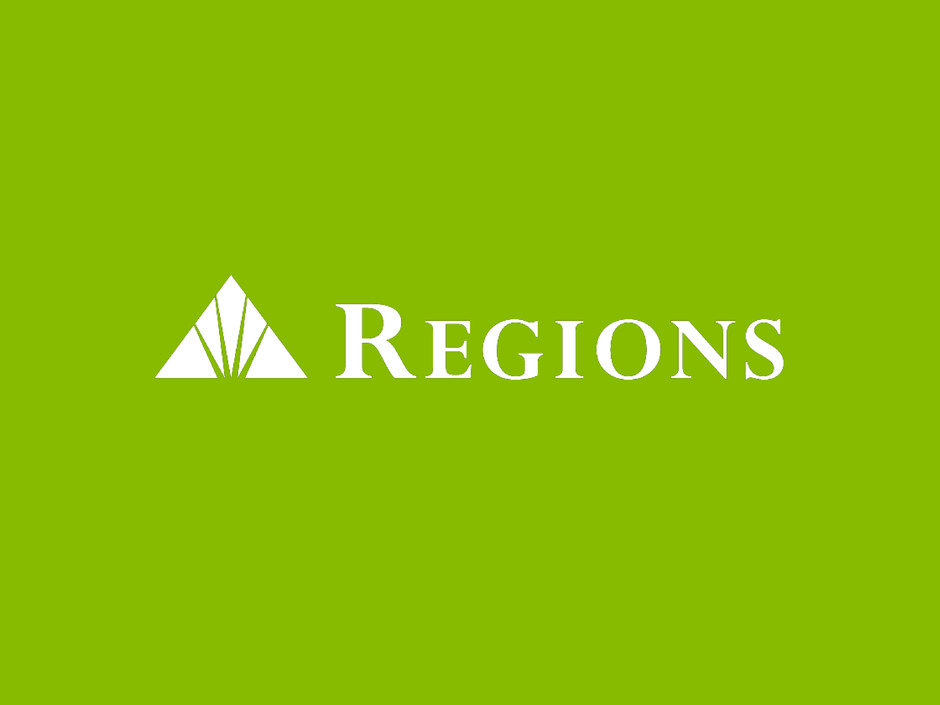
24
